ICR took the opportunity to assist them with this excavation in June 2020. Rock and fossil features that fit the Flood model of Earth history became apparent through this unique experience. The excavation took place in an outcrop of the Smoky Hill Chalk Member of the Niobrara Formation, whose rock layers are famous for fossils of fish, giant clams, and flying reptiles. Every rainy season or even a storm can erode sediments and expose new fossils.
The excavation team’s first step was to clear a wide space around the vertebrae, carefully searching for fossilized bones. The sediment was soft enough that they could be removed with wooden chisels and brushes. Soon more bones appeared. By the first afternoon, we had uncovered long bones, bone fragments, a tooth, and some dark, mysterious debris. After discovering more than 40 associated bones, we felt confident that the work had been worthwhile.
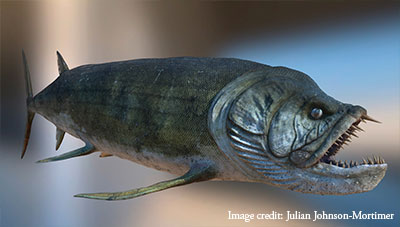
Rocks and fossils of the region
The most abundant vertebrate fossil from this region is probably the famous fish called Xiphactinus , which is what we found. Many fossil museums have one mounted in their halls. The rarest specimen includes a swallowed fish inside a huge Xiphactinus ribcage. Xiphactinus looked like a clawfish with its large, toothy mouth.
Among these fish were flying reptiles, along with clams, sharks, mosasaurs, plesiosaurs, turtles, birds, and a few dinosaurs.1 Few, if any, creatures that lived on hard ground—such as camels, dogs, or deer—died in the carbonate muds that would become the Niobrara Chalk. Wetland creatures landed here, as did those in other rock layers with similar age assignments and fossils.2 Where on Earth today are creatures of the sea, swamps, and sky fossilized together in mud? Nowhere. These rocks and their fossils demarcated a wide-ranging aquatic catastrophe.
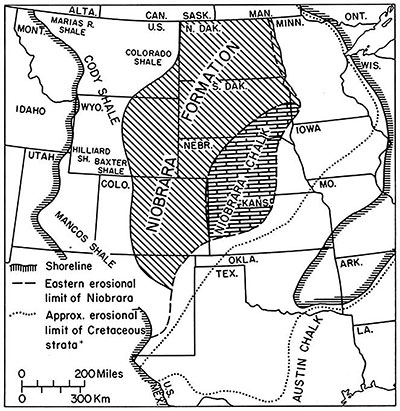
Figure 1. Aerial extent of the Niobrara Formation Image credit: Donald E. Hattin4*”†“Cretaceous strata” refers to sediments deposited near the middle of the Flood.
But how wide is it? Figure 1 reproduces a 1982 map by Donald Hattin of the Kansas Geological Survey showing the extent of the Niobrara Formation in the United States. But members of this same rock system extend far beyond this map, from the Gulf of Mexico to Arctic Canada. Outcrops adjacent to the Niobrara Formation go by various names in different areas, including the Mesa Verde Formation in southern New Mexico, the Niobrara Shale Member in northern New Mexico, the Mancos Shale in Colorado, the First White Buttes in Montana and Canada, and the Niobrara Formation in Manitoba. Something deposited all this stratified sediment at the same time. The Great Flood comes to mind.
Many outcrops of the Smoky Hill Chalk show their characteristic gray layers beneath light tan layers. The gray rocks are thinner in layering than the tan rocks above them. Where else in the world are the same color and layering patterns deposited today across thousands of square miles? Nowhere.
The layers immediately above and below our Xiphactinus fossil ranged from a centimeter to four centimeters thick. Where are muds deposited today in layers that remain intact until they harden into rock? This happens at the sites of catastrophes. For example, mudflows at Mount St. Helens in the early 1980s deposited layers that are still visible today. Similarly, high-energy gravitational flows on the marine shelf deposit layers with ordered grain sizes, like those seen in shale rocks on land. Smaller storms can deposit layers in stream beds or river deltas, but animals disturb these surface layers in just a few months. No creatures disturbed the layers of the Niobrara, suggesting a widespread aquatic catastrophe.
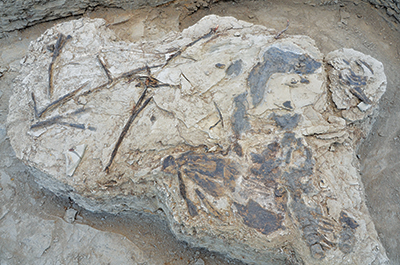
Figure 2. Fossil bones exposed in the Smoky Hill Chalk in Kansas Image credit: Brian Thomas
Where did all the mud come from that ended up scattered across the West in the Niobrara chalks and shales? Geologist Donald Hattin wrote: “The Niobrara Chalk of Kansas represents the deposition of carbonate-dominated muds far from major western sources.”4 The presence of fast-moving water must have carried the numerous grains a great distance. Today’s rivers can carry sediment for miles, but they deposit those grains on flowing riverbanks or in fan-shaped deltas where the river meets the sea. In contrast, the Niobrara Formation is much larger than the world’s largest river deltas. Where is the familiar fan shape of river deltas? Figure 1 shows no such thing. Clearly, some unusually immense process deposited the Niobrara. Noah’s Flood fits the bill.
The big fish
Figure 2 shows the upper surfaces of 48 bones exposed during our excavation. At first, we hoped it might be a Pteranodon , but fossil preparation in the lab yielded more bones beneath these 48. By carefully removing the matrix from around the upper bones with a dental pick, a preparator created a large, toothed Xiphactinus maxilla (jaw), shown in Figure 3.
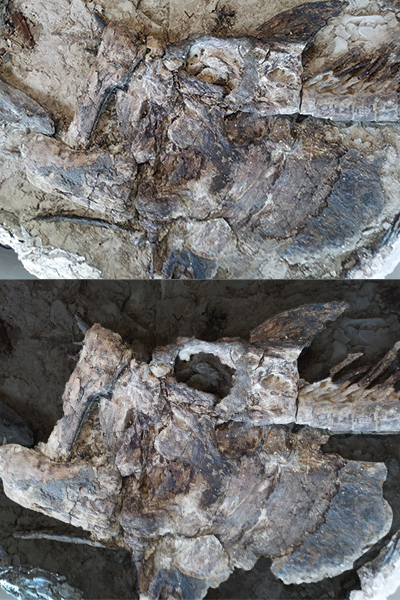
Figure 3. Enhanced outline of bones, including the jaw and its teeth, discovered in the lab shows a fish fossil. Image credit: Scott Arledge
Some of the fossil’s vertebrae remained aligned, but some were displaced and others were crushed. During excavation, long bones appeared on the left, but not the right side of the main body. All the bones lie in a single layer about three centimeters thick. In life, this fish had a bony operculum covering its gills. Our fish’s operculum had been pushed about 40 centimeters away from its head. Overall, it seems that forces folded, flattened, and threw this Xiphactinus into pieces. It did not die peacefully.
The tortured state of their remains contrasts with centuries-old imagined scenes of fossilization of placid fish that sank to the bottom of some ancient calm sea. Where in the present-day seabeds do the remains of fish or birds fossilize? None. They are hastily devoured. Why did these creatures not fall prey to scavengers? Rapid burial in mud explains the fossils. The folded and forcibly dislodged fossils imply the murky waters that Noah’s year-long Flood would have provided.
Our fossil excavators carefully removed sediment from the top and side surfaces of the exposed bones. We added polyvinyl acetate (glue) to the bones to prevent them from flaking off. Distinguishing bone from matrix in person is easy, but these bones can be difficult to see in photographs. The sheen of the glue helped separate the bones for clearer photographs (see Figure 2).
The excavated area took on a rounded shape of about 140 × 120 centimeters. We divided this area into four smaller plots, each excavated separately. Figure 4 shows the author and the fossil discoverer excavating a smaller plot within the fossil area. The inclusion of much of the matrix surrounding each fossil region plus the added plaster cover resulted in very heavy packages. The largest package included the vertebral column and head. Five men struggled to carry it up the hill to a vehicle about 25 meters from the excavation site.
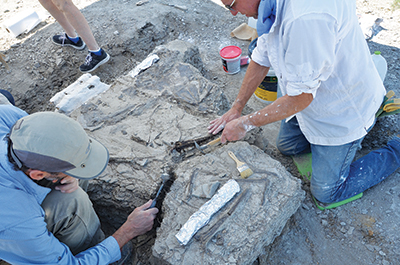
Figure 4. The author (left) and the fossil’s discoverer (right) use hammer picks to remove the matrix from beneath the fossil. Image credit: Brian Thomas
One of the team members discovered a shark tooth between the fish’s long bones and vertebrae, but with a thin layer underneath. The tooth looked like that of a modern dusky shark. Another tooth similar to that of a lemon shark lay on the ground not far away. Some animals in the fossil record became extinct, but others look the same today. These fossils don’t show evolution, just extinction or sameness.
Our team also found fish coprolites. These once-soft fossils of animal waste are now white, chalky, and about the diameter of an adult human finger. Where do coprolites form today? Nowhere. The preservation of such cold organic material suggests rapid decomposition and quick drying. Left wet, bacteria would have broken it down long before it had a chance to absorb minerals and harden. The year-long Flood of Noah’s time provides a sensible context in which to place these clues.
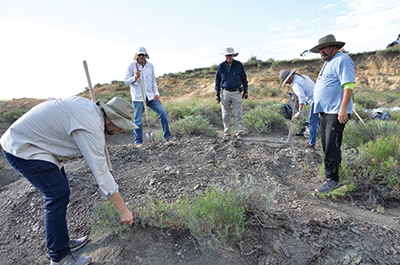
Figure 5. Workers remove shrubs from the excavation site. The shrubs’ roots grew around the still-nutritious bones, implying recent bone excavation. Image credit: Brian Thomas
Most of the shrub roots penetrated the rock layers surrounding the Xiphactinus fossil. Figure 5 shows team members removing shrubs at the excavation site. Several roots ran parallel to the long bones, and rootlets wrapped around several fossil bones more densely than in the surrounding sediment. Plant roots use chemotropism to grow toward nutrient sources. That means the bones still have nutrients that these plants are seeking out.
These root associations show that some of the original bone chemistry (and possibly even biochemistry) might remain. If so, then these bones have not been in the ground long enough to completely decompose and dissolve. Nor have they turned entirely into rock. In either case, the roots would ignore them. The fact that the flood occurred only thousands of years ago would explain the existence of still-nutritious, fresh-looking fossils.




